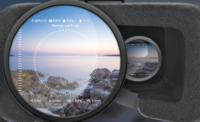Beachwood, Ohio-based Tremco Roofing and Building Maintenance teamed up with Toronto-based Industrial SkyWorks, an unmanned aerial vehicle (UAV) and data solutions company that received the first-ever approval for nighttime flights in the U.S.—moving the construction industry to the forefront of the UAV field.
The team did a lot of work to get the exemption, says Robb Chauvin, executive director inspection services, Termco. “We started doing night jobs in Canada a year and half ago,” he says, adding that, at the time, the operator started petitioning the Federal Aviation Administration for the exemption.
Tremco uses the technique at night because of how a building cools from the heat of the day.
“The daytime solar loads heat up the roof,” says Michael Cohen, president at Industrial SkyWorks. “Once the sun goes down, the roof cools to a baseline outdoor temperature. And the wet and dry temperatures of the roof cool at a different rate. The thermographic technology allows us to capture that [in the] image.”
Thermal mapping reveals where buildings are losing heat. Traditional means of thermal mapping require scaffolding or swing stages to get workers up and down—and then for technicians to walk the roof at night, scanning by hand—a feat that Chauvin says is dangerous and time consuming.
“It’s easy to forget you’re on a roof when it’s a million square feet,” says Chauvin. “The safety play here is huge.”
The FAA approved the SkyRanger model UAV from Aeryon in the exemption. It’s outfitted with what Tremco calls the SkyBEAM, or “building envelope asset mapping,” system, which pairs a 20-megapixel camera and the FLIR Quark 2 thermal-imaging camera. The latter device produces scans that look similar to an X-ray, says Cohen.
“One of the great advantages of SkyBEAM is doing thermal mapping of the facade. We can now fly this up and map the entire building envelope, not just the roof,” says Chauvin.
The drone hasn’t replaced the inspectors; it has just sped up operations, notes Chauvin. “We still walk the roof to identify anomalies and hot spots in person after the scan,” he says. But the speed between a UAV scan and an inspector scan is massive.
“Work time goes from five hours to 15 minutes, allowing us to carry out operations in peak environmental conditions,” says Cohen.
A good thermal reading is available only for a few hours after sunset, when roofing materials still radiate enough solar heat.
“In Canada, a customer had 1.1 million square feet of roofing that we scanned with SkyBEAM in two and a half hours,” says Chauvin. It would take technicians four nights to scan that much roofing because of the limited work window, he adds.
Other companies trying to attain a nighttime FAA exemption may be up against a long process, says Chauvin.
“If they have 18 months to wait and they have a licensed pilot with an airman’s health certificate and a dedicated visual observer, that’s a start,” says Chauvin, who adds that the partnership’s previous experience doing night operations in Canada was its proof of concept to help secure U.S. approval.





Post a comment to this article
Report Abusive Comment